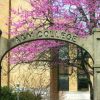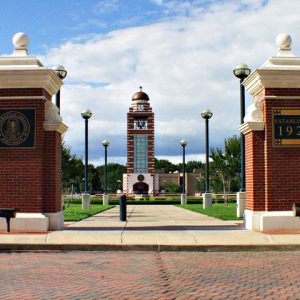calsfoundation@cals.org
University of Arkansas at Fort Smith (UAFS)
The University of Arkansas at Fort Smith (UAFS) is a state-supported liberal arts institution of higher education with its main campus located near Interstate 540 in the north-central part of the city. The 164-acre campus is a local landmark highly prized by Fort Smith (Sebastian County) area citizenry for its well-kept beauty.
Founded in 1928 by the local school board as an extension of the high school, Fort Smith Junior College (FSJC) had thirty-four students in its first class. Financed in the beginning out of the high school budget, the college was established during a national educational movement toward two-year colleges. In 1937, FSJC students moved out of the high school itself into their own classrooms, which had been built into the new football stadium. In 1950, the college separated altogether from the high school and moved to the outskirts of the town into a spare building on the county poor farm. There, along a narrow street shaded by oak trees, FSJC re-chartered itself as a private institution and sought to support itself solely through tuition and private donations. Elmer Cook became the first president of the college with its move to the separate campus.
Students, faculty, and administrators swept hallways, washed windows, and painted the inside walls of the brick three-story building that was soon rechristened Old Main and which would house offices, classrooms, a student lounge, and a cafeteria. Students laid out a baseball field on the farm’s former garden plot. The Lions basketball team and its pep band hitched rides across town for practice and varsity games in the gym and facilities of the Fort Smith Boys Club. The college named its two annual faculty achievement awards after Lucille Speakman and Luella Krehbiel, pioneering instructors who, in the early years, sometimes returned part of their meager paychecks to help keep the college solvent.
The private college struggled financially until Amendment 52 to the state constitution in 1964 allowed two-year colleges, for the first time, to receive public funding. This was brought about particularly by the persuasive work of Shelby Breedlove, the third president of the college. For the now publicly supported college, stability brought with it a steady growth over a period of years. To reflect increased educational responsibilities and programs, the governing board of trustees changed the name of the institution in 1966 to Westark Junior College (WJC) and then in 1972 to Westark Community College (WCC). Fort Smith native Joel Richard Stubblefield, who served as president of the college for twenty years, oversaw the mushrooming student enrollment, millage support from the city and county, and the construction of impressive new facilities during this time period. In 1998, the institution became Westark College.
Westark College had gained a reputation as the flagship of Arkansas junior colleges because of the academic achievements of its transfer students at four-year schools, a tenured faculty, its substantial endowment fund, and enthusiastic community support. However, it was increasingly clear that a city of more than 80,000 with a seven-county commuter area of 270,000 people, the second-largest urban area in the state, needed a full-fledged university. On January 1, 2002, the college formally merged into the University of Arkansas System and became the University of Arkansas at Fort Smith. In ceremonies on November 14, 2006, over 1,000 faculty, staff, students, townspeople, state representatives, and University of Arkansas system dignitaries participated in the investiture of Chancellor Paul B. Beran, who in his acceptance speech put forward his goal for the institution to become a leading regional university. In 2019, Terisa Riley was appointed chancellor to replace Beran; she announced her commitment to diversity, cooperation, and opportunities for student learning and achievement at UAFS.
UAFS had 232 full-time faculty members in early 2020. The main campus consists of sixty-five buildings, including dormitories, a 3,000-seat all-events arena, the Boreham Library with the Pebley Center archives, and Pendergraft Health Sciences, Math-Science, and Flanders Business and Industrial Institute buildings. The Breedlove Auditorium is home to the award-winning performing arts and music departments. The Baldor Technology Center encompasses applied science and technology departments. The Smith-Pendergraft Campus Center houses student activities staff, the campus bookstore, recreational rooms, a ballroom, and a food court. In 2015, the university opened the Windgate Art and Design building, followed by its Recreation and Wellness Center in 2016. The Drennen-Scott Historic Site in Van Buren (Crawford County), a circa 1836 log house purchased with the help of the Arkansas Natural and Cultural Resources Council, operates the Visitor and Interpretive Center staffed by faculty and students from the UAFS Department of History.
Four-year athletics replaced the nationally competitive two-year athletic programs. School teams, the Lions and Lady Lions, have won three national basketball championships—two men’s (1981 and 2006) and one women’s (1995). Basketball and volleyball games are played at the 3,000-seat Gayle Kaundart Arena at the Stubblefield Center and baseball on campus at Bill Crowder Field. Cross country, tennis, and golf round out the varsity sports. UAFS is a member of NCAA Division II Lone Star Conference.
Students enroll in undergraduate studies to pursue one of the forty-two baccalaureate degrees offered. Students in graduate school at UAFS seek one of two master’s degrees, an MS in healthcare administration or an MEd with curriculum or English emphasis. The Myles Friedman Honors Program, a variety of clubs, Greek sororities and fraternities, intramurals, international student programs, the American Democracy Project, and cultural activities make up student life. Applause, the campus literary magazine, is acclaimed for its student and faculty compositions. Enrollment for the fall of 2023 was 5,514 students.
For additional information:
Combs, Roger, and J. C. Hoffman. “Westark Community College: The Early Years.” Unpublished manuscript, 1996. On file at the Pebley Center, Boreham Library. University of Arkansas at Fort Smith, Fort Smith, Arkansas.
Higgins, Billy, Stephen Husarik, and Henry Rinne. History of Westark College. Fort Smith, AR: Westark College Foundation, 1998.
———. University of Arkansas–Fort Smith: The First 85 Years, 1928–2012. Fort Smith: UAFS Press, 2012.
University of Arkansas at Fort Smith. http://uafs.edu/ (accessed March 20, 2024).
“Westark Community College.” Journal of the Fort Smith Historical Society 15 (April 1991): 3–16.
Billy D. Higgins
University of Arkansas at Fort Smith
 Education, Higher
Education, Higher University of Arkansas at Fort Smith
University of Arkansas at Fort Smith 




Comments
No comments on this entry yet.